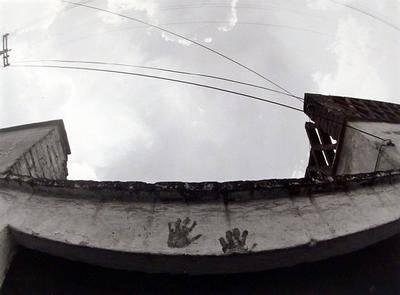
Manuel Álvarez Bravo
Mexican, 1902-2002
Manos en Casa de Diaz (Hands on Diaz's House), 1976
gelatin silver print
7 1/8 x 9 3/8 in.
SBMA, Gift of Mr. Rudolph Demasi
1979.69.12

Undated Self-Portrait
"I don’t plan a photograph in advance… I work by impulse. No philosophy. No ideas. Not by the head but by the eyes. Eventually inspiration comes - instinct is the same as inspiration, and eventually it comes." - Manuel Álvarez Bravo
“Shoot what you see not what you think.” - Manuel Alvarez Bravo
RESEARCH PAPER
Manuel Alvarez Bravo is the most renowned Latin American photographer of the 20th century. In fact his life, 1902-2002, spanned the entire century. In his 1976 photograph “Hands on Diaz’s House”, we see the upper part of a house from Colonia Coyoacan, a suburb of Mexico City.
The lower half of the photograph shows the angular forms of the upper parts of a building. They
have amazing depth, width and height for a one dimensional photograph. It is considered a” photograph of form.” There is rich texture, another hallmark of Alvarez Bravo’s work. There are 7-9 values, or shades, in this black and white photograph, ranging from the deep black at the bottom to the white that outlines the dramatic clouds that fill the upper half of the photograph.
While this is a photograph of form, the most interesting part of the photo is the hands. They look like handprints, but we realize they are marks on the house made to look like handprints. The handprints can be symbolic of the art of prehistoric man. After drawing or painting on cave walls these early artists left their handprints as if to say, “I was here and I did this.” In ancient Mexico hands were symbols of the vital energy and the creative powers that the gods gave to man. (Mraz in Revelaciones)
Or could the hands be those of someone seeking to climb out of or escape from the house? The curved telephone wires, while contrasting with the angular forms of the building, repeat the curve of the wal just above the opening to the interior. One could even imagine that the curved wires could serve to catapult the escapee out of the enclosure and into freedom. The free flowing forms of the clouds add to a feeling of unlimited movement in an unrestricted area.
Alvarez Bravo followed in the steps of his grandfather, a professional portrait maker, and his father, who also pursued photography. He was primarily self-taught. When photographer Tina Modotti was expelled from Mexico for her political activities she left him her large-format camera. She introduced him to the artistic giants of the time, Diego Rivera, Frida Kahlo, Jose
Clemente Orozco. Edward Weston was impressed with the young photographer. Alvarez Bravo was only 20 when Weston visited Mexico in 1922. He also worked with Paul Strand. Although his acclaim expanded to the U.S. largely after 1970 when he returned to MOMA in New York for a solo exhibition, well-known photographers recognized his talent decades earlier. In 1938 Andre Breton commissioned him to do the catalog cover for an exhibition of surrealists. Once when someone remarked that Alvarez Bravo’s work was similar to Edward Weston, Henri Cartier-Bresson replied, “Don’t compare them, Manuel is the real artist.” (Mraz in Revelaciones)
Alvarez Bravo’s career was formed after the Mexican Revolution which ended in 1920. In that era the people of Mexico began a search for their identity. They wanted to be a part of the modern world, but remain deeply connected to their cultural roots. These indigenous roots had been disparaged for centuries, from the time the Spaniards conquered Mexico in the early 1500’s. Alvarez Bravo’s brilliance was his ability to capture the most humble people in their natural settings. He does not create or stage them. He finds his subjects going about their lives. He does not romanticize or sentimentalize them. He captures their indigenous culture, their “mexicanidad.” (Mraz in Revelaciones) This surely is Alvarez Bravo’s greatest contribution to photography and to his fellow Mexicans. Perhaps the hands on Diaz’s house are those of the modern Mexican denouncing racial prejudice and celebrating his indigenous cultural heritage.
Prepared for the Santa Barbara Museum of Art Docent Council by Kathe Hines, 2020
BIBLIOGRAPHY
Sims, Delphine. Introduction in “Looking In, Looking Out: Latin American Photography”. Santa Barbara, California: Santa Barbara Museum of Art and Nazraeli Press, 2015.
Alvarez Bravo, Manuel. “Hands on Diaz’s House.” January 14, 2020
https://docentssbma.org/alvarez-bravo-manos-dn-casa-de-diaz
Websites
http://www.quotefancy/Manuel Alvarez Bravo, 01/14/2020
“Manuel Alvarez Bravo”, 01/14/2020
http://www.museoamparo.com/artistas/perfil/25/manuel-alvarez-bravo
http://www.manuelalvarezbravo.org
“Manuel Alvarez Bravo Mexican,1902-2002”, 01/14/2020
http://www.moma.org/artists/135
“Cronologia”, 01/14/2020
http://www.manuelalvarezbravo.org/cronologia
“Manuel Alvarez Bravo”, 01/12//2020
http://www.enwikipedia.org/wiki/Manuel_Alvarez_Bravo
Mraz, John, “Manuel Alvarez Bravo: Ironizing Mexico”, Revelaciones, February 03, 2002. January 19, 2020
http://v2.zonezero.com/index.php?option=com_content&view=article&id=970%3Awhats-documentary-about-photography-from-directed-to-digital-photojournalism&catid=5%3Aarticles&lang=en
COMMENTS
The western influences in the work of Don Manuel are most obvious to the non-Mexican. Mysterious images such as “Pared con mano” (1974) and “Manos en casa de Diaz” (1976) take their source and inspiration from the beginning of all art – the handprints of prehistoric cavedwellers, asserting their existence. These signs, however, have additional symbolic meanings drawn from ancient Mexico, where hands were associated with creative power (artistic and other) and symbolized the vital energy that gods impart to mortals. Similarly, many of the naïve wall paintings and signs, such as “Paisage y galope” (1932) photographed by Alvarez Bravo bear resemblance to buffaloes and other beasts painted on cave walls in Lascaux and Altamira. This is not artistic mimesis; rather, it is expression of sympathy and spiritual communion with earlier artists who, as Kandinsky wrote, “…sought to express in their work only internal truths, renouncing in consequence all consideration of external form."
- Revelaciones: The Art of Manuel Alvarez Bravo, Museum of Photographic Arts, San Diego, CA, 1990, p. 16.
